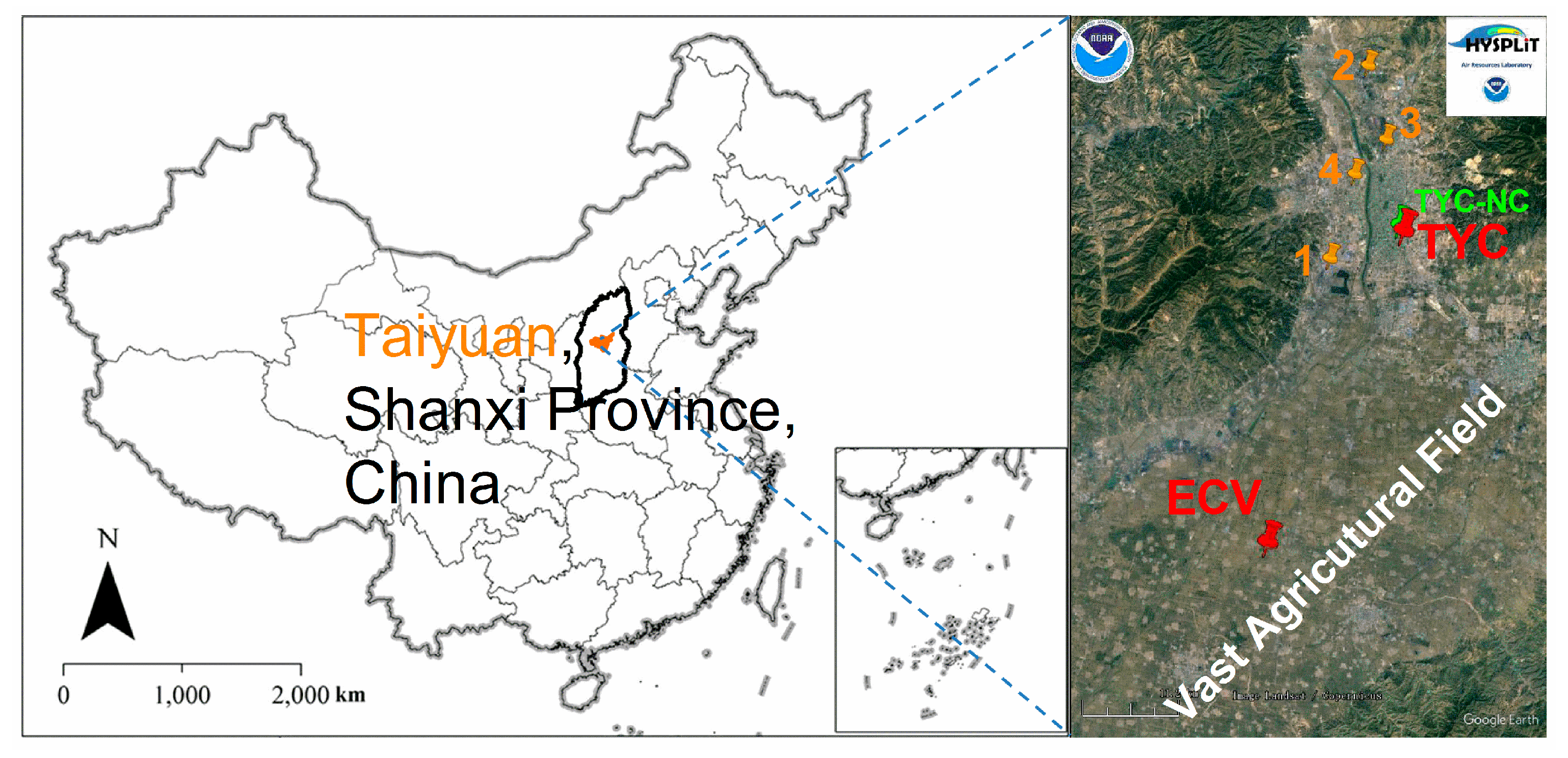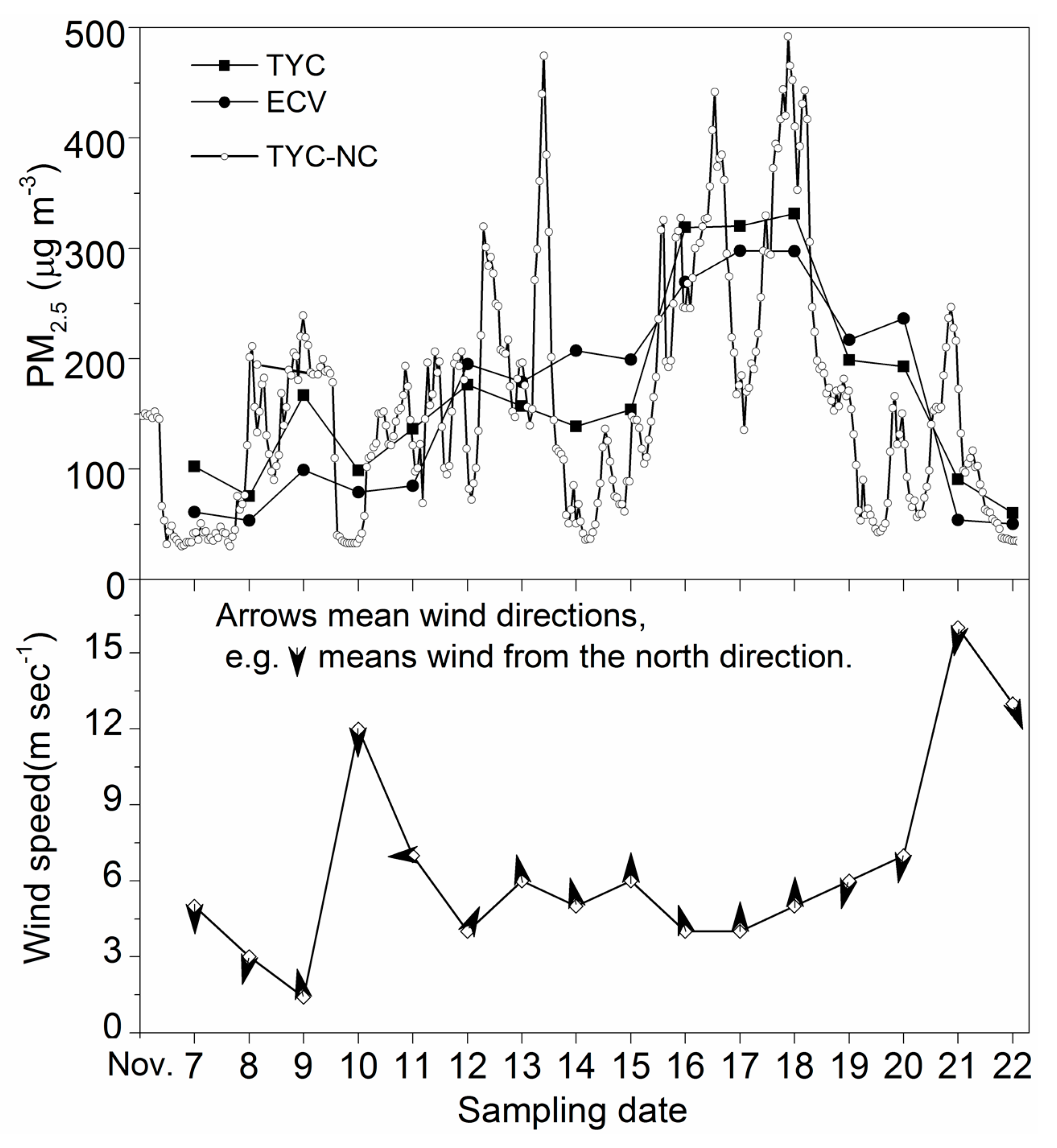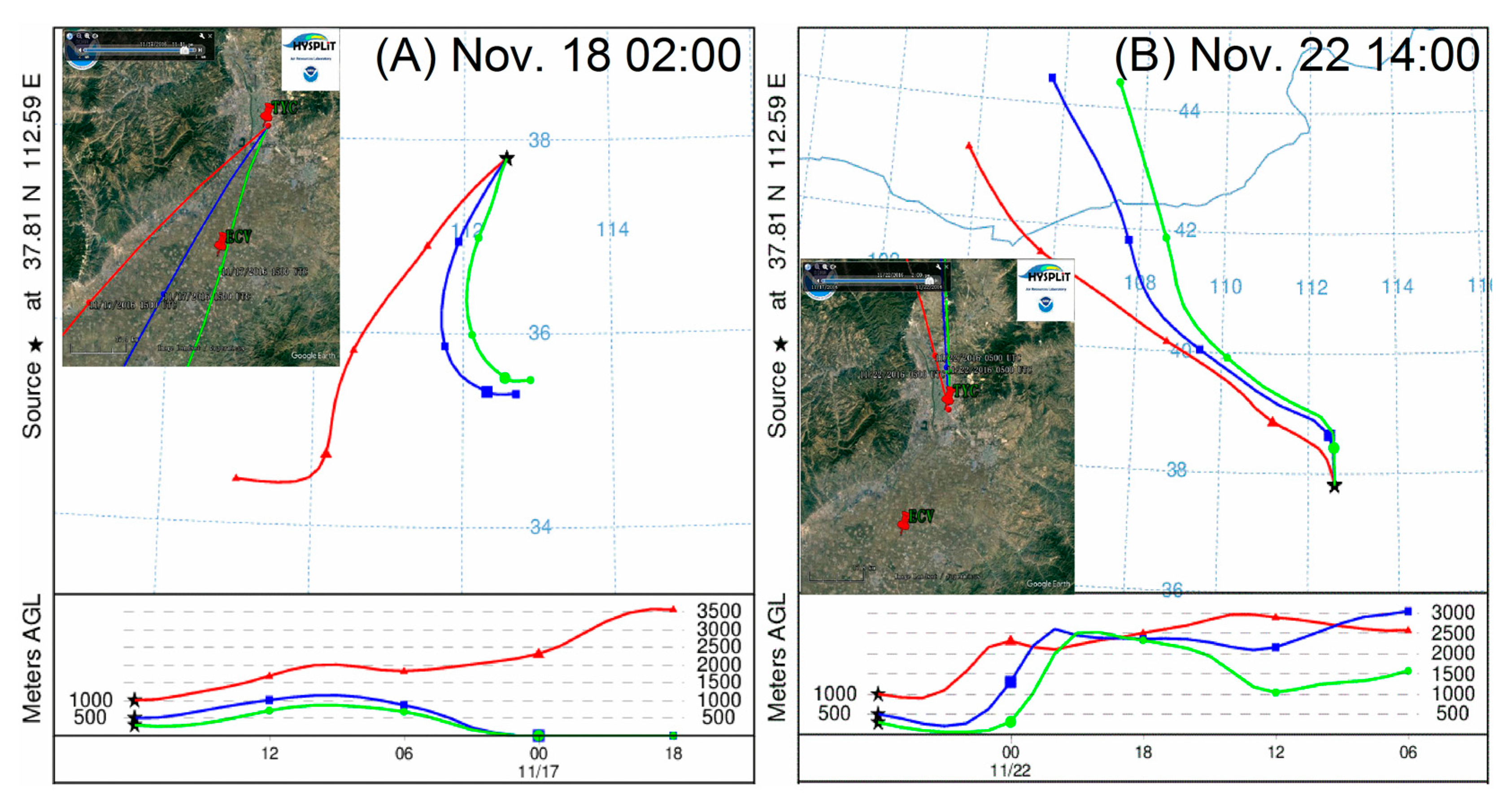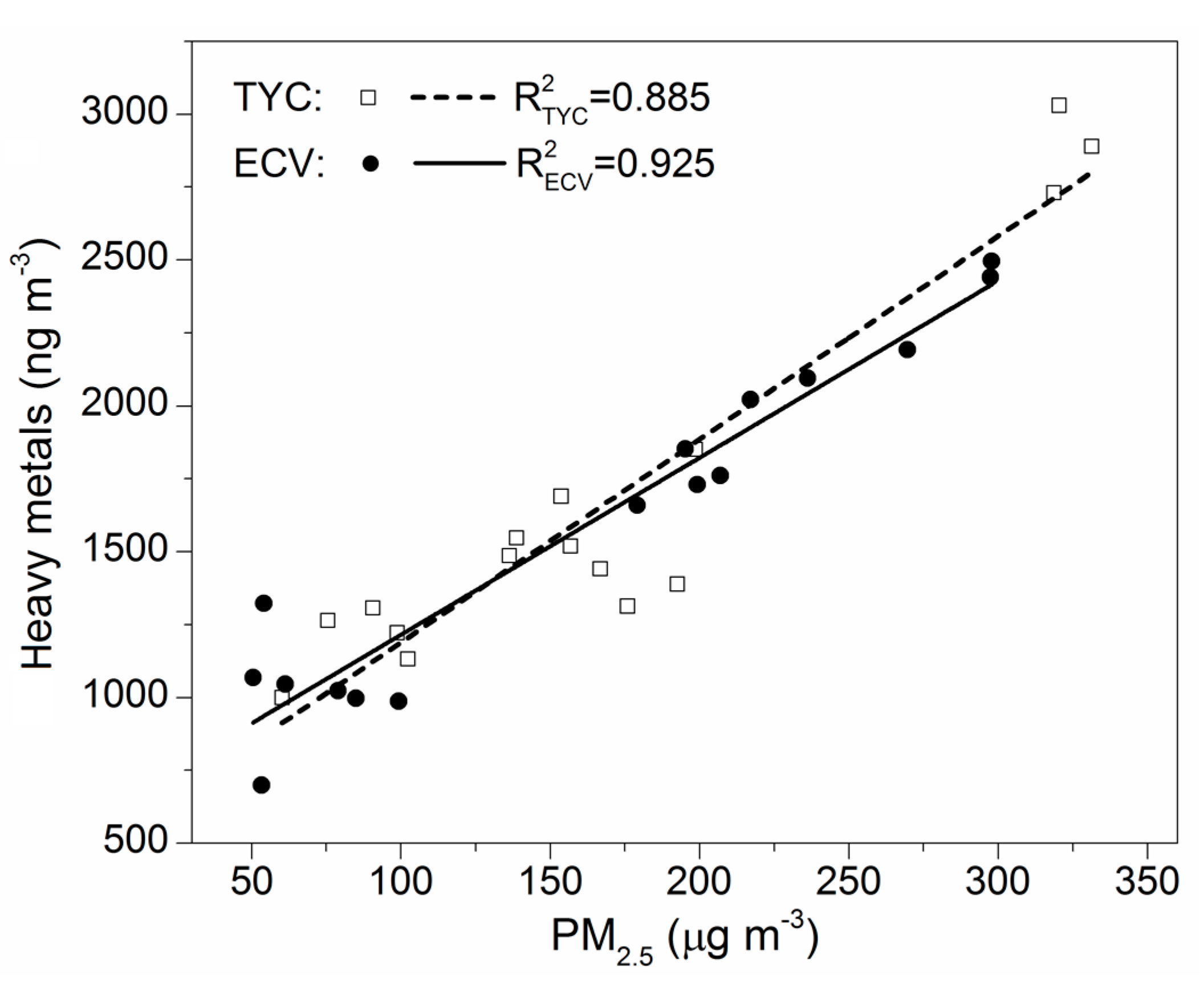Characteristics and Sources of Heavy Metals in PM2.5 during a Typical Haze Episode in Rural and Urban Areas in Taiyuan, China
Abstract
:1. Introduction
2. Experiments
2.1. Description of the Study Area
2.2. Sampling
2.3. Analysis of Heavy Metals
3. Results and Discussion
3.1. Levels of PM2.5
3.2. Levels of Heavy Metals in PM2.5
3.3. Source Identification
4. Conclusions
Acknowledgments
Author Contributions
Conflicts of Interest
References
- Zhai, Y.; Liu, X.; Chen, H.; Xu, B.; Zhu, L.; Li, C.; Zeng, G. Source identification and potential ecological risk assessment of heavy metals in PM2.5 from Changsha. Sci. Total Environ. 2014, 493, 109–115. [Google Scholar] [CrossRef] [PubMed]
- Liang, C.S.; Duan, F.K.; He, K.B.; Ma, Y.L. Review on recent progress in observations, source identifications and countermeasures of PM2.5. Environ. Int. 2016, 86, 150–170. [Google Scholar] [CrossRef] [PubMed]
- Liu, P.; Zhang, C.; Mu, Y.; Liu, C.; Xue, C.; Ye, C. The possible contribution of the periodic emissions from farmers’ activities in the North China Plain to atmospheric water-soluble ions in Beijing. Atmos. Chem. Phys. 2016, 16, 10097–10109. [Google Scholar] [CrossRef]
- Chen, G.; Zhang, W.; Li, S.; Zhang, Y.; Williams, G.; Huxleyd, R. The impact of ambient fine particles on influenza transmission and the modification effects of temperature in China: A multi-city study. Environ. Int. 2017, 98, 82–88. [Google Scholar] [CrossRef] [PubMed]
- Yang, Y.; Zhou, R.; Yan, Y.; Yu, Y.; Liu, J.; Di, Y.; Du, Z.; Wu, D. Seasonal variations and size distributions of water-soluble ions of atmospheric particulate matter at Shigatse, Tibetan Plateau. Chemosphere 2016, 145, 560–567. [Google Scholar] [CrossRef] [PubMed]
- Guo, S.; Hu, M.; Zamora, M.L.; Peng, J.; Shang, D.; Zheng, J. Elucidating severe urban haze formation in China. Proc. Natl. Acad. Sci. USA 2014, 111, 17373–17378. [Google Scholar] [CrossRef] [PubMed]
- Huang, R.; Zhang, Y.; Bozzetti, C.; Ho, K.F.; Cao, J.; Han, Y. High secondary aerosol contribution to particulate pollution during haze events in China. Nature 2014, 514, 218–222. [Google Scholar] [CrossRef] [PubMed] [Green Version]
- Zhang, R.; Jing, J.; Tao, J.; Hsu, S.C.; Wang, G.; Cao, J. Chemical characterization and source apportionment of PM2.5 in Beijing: Seasonal perspective. Atmos. Chem. Phys. 2013, 13, 7053–7074. [Google Scholar] [CrossRef]
- Pui, D.Y.H.; Chen, S.C.; Zuo, Z. PM2.5 in China: Measurements, sources, visibility and health effects, and mitigation. Particuology 2014, 13, 1–26. [Google Scholar] [CrossRef]
- Tang, D.; Wang, C.; Nie, J.; Chen, R.; Niu, Q.; Kan, H. Health benefits of improving air quality in Taiyuan, China. Environ. Int. 2014, 73, 235–242. [Google Scholar] [CrossRef] [PubMed]
- Uno, I.; Sugimoto, N.; Shimizu, A.; Yumimoto, K.; Hara, Y.; Wang, Z. Record heavy PM2.5 air pollution over China in January 2013: Vertical and horizontal dimensions. Sola 2014, 10, 136–140. [Google Scholar] [CrossRef]
- Zheng, G.J.; Duan, F.K.; Su, H.; Ma, Y.L.; Cheng, Y.; Zheng, B. Exploring the severe winter haze in Beijing: The impact of synoptic weather, regional transport and heterogeneous reactions. Atmos. Chem. Phys. 2015, 15, 2969–2983. [Google Scholar] [CrossRef]
- Liu, M.; Huang, Y.; Ma, Z.; Jin, Z.; Liu, X.; Wang, H. Spatial and temporal trends in the mortality burden of air pollution in China: 2004–2012. Environ. Int. 2017, 98, 75–81. [Google Scholar] [CrossRef] [PubMed]
- Buseck, P.R.; Pósfai, M. Airborne minerals and related aerosol particles: Effects on climate and the environment. Proc. Natl. Acad. Sci. USA 1999, 96, 3372–3379. [Google Scholar] [CrossRef] [PubMed]
- Cheng, Y.; Eichler, E.; Wiedensohler, A.; Heintzenberg, J.; Zhang, Y.; Hu, M. Mixing state of elemental carbon and non-light-absorbing aerosol components derived from in situ particle optical properties at Xinken in Pearl River Delta of China. J. Geophys. Res. 2006, 111, D20204. [Google Scholar] [CrossRef]
- Chubarova, N.E. Influence of aerosol and atmospheric gases on ultraviolet radiation in different optical conditions including smoky mist of 2002. Dokl. Earth Sci. 2004, 394, 62–67. [Google Scholar]
- Tzanis, C.; Tsivola, E.; Efstathiou, M.; Varotsos, C. Forest fires pollution impact on the solar UV irradiance at the ground. Fresenius Environ. Bull. 2009, 18, 2151–2158. [Google Scholar]
- Varotsos, C.; Efstathiou, M.; Tzanis, C.; Deligiorgi, D. On the limits of the air pollution predictability: The case of the surface ozone at Athens, Greece. Environ. Sci. Pollut. Res. 2012, 19, 295–300. [Google Scholar] [CrossRef] [PubMed]
- Yun, H.J.; Yi, S.M.; Kim, Y.P. Dry deposition fluxes of ambient particulate heavy metals in a small city, Korea. Atmos. Environ. 2002, 36, 5449–5458. [Google Scholar] [CrossRef]
- Amanollahi, J.; Tzanis, C.; Abdullah, A.M.; Ramli, M.F.; Pirasteh, S. Development of the models to estimate particulate matter from thermal infrared band of Landsat Enhanced Thematic Mapper. Int. J. Environ. Sci. Technol. 2013, 10, 1245–1254. [Google Scholar] [CrossRef]
- Haywood, J.; Boucher, O. Estimates of the direct and indirect radiative forcing due to tropospheric aerosols: A review. Rev. Geophys. 2000, 38, 513–543. [Google Scholar] [CrossRef]
- Zhang, N.; Han, B.; He, F.; Xu, J.; Niu, C.; Zhou, J.; Kong, S.; Bai, Z.; Xu, H. Characterization, health risk of heavy metals, and source apportionment of atmospheric PM2.5 to children in summer and winter: An exposure panel study in Tianjin, China. Air Qual. Atmos. Health 2015, 8, 347–357. [Google Scholar] [CrossRef]
- Lai, C.H.; Lin, C.H.; Liao, C.C. Respiratory deposition and health risk of inhalation of particle-bound heavy metals in the carbon black feeding area of a tire manufacturer. Air. Qual. Atmos. Health. 2017. [Google Scholar] [CrossRef]
- Heys, K.A.; Shore, R.F.; Pereira, M.G.; Jones, K.C.; Martin, F.L. Risk assessment of environmental mixture effects. RSC Adv. 2016, 6, 47844–47857. [Google Scholar]
- Rodriguez-Espinosa, P.F.; Flores-Rangel, R.M.; Mugica-Alvarez, V.; Morales-Garcia, S.S. Sources of trace metals in PM10 from a petrochemical industrial complex in Northern Mexico. Air Qual. Atmos. Health 2017, 10, 69–84. [Google Scholar] [CrossRef]
- Pope, C.A.; Burnett, R.T.; Thun, M.J.; Calle, E.E.; Krewski, D.; Ito, K.; Thurston, G.D. Lung cancer, cardiopulmonary mortality, and long-term exposure to fine particulate air pollution. JAMA 2002, 287, 1132–1141. [Google Scholar] [CrossRef] [PubMed]
- Dockery, D.W.; Pope, C.A. Acute respiratory effects of particulate air pollution. Annu. Rev. Public Health 1994, 15, 107–132. [Google Scholar] [CrossRef] [PubMed]
- Pope, C.A.; Dockery, D.W. Health effects of fine particulate air pollution: Lines that connect. J. Air Waste Manag. Assoc. 2006, 56, 709–742. [Google Scholar] [CrossRef] [PubMed]
- International Agency for Research on Cancer (IARC). Agents Classified by the IARC Monographs, Vol. 1–120. Available online: http://monographs.iarc.fr/ENG/Classification/ClassificationsAlphaOrder.pdf (assessed on 27 October 2017).
- Cheng, X.; Huang, Y.; Long, Z.; Ni, S.; Shi, Z.; Zhang, C. Characteristics, Sources and Health Risk Assessment of Trace Metals in PM10 in Panzhihua, China. Bull. Environ. Contam. Tox. 2016, 98, 76–83. [Google Scholar] [CrossRef] [PubMed]
- Xue, M.; Yang, Y.; Ruan, J.; Xu, Z. Assessment of Noise and Heavy Metals (Cr, Cu, Cd, Pb) in the Ambience of the Production Line for Recycling Waste Printed Circuit Boards. Environ. Sci. Technol. 2012, 46, 494–499. [Google Scholar] [CrossRef] [PubMed]
- Ferreira-Baptista, L.; De Miguel, E. Geochemistry and risk assessment of street dust in Luanda, Angola: A tropical urban environment. Atmos. Environ. 2005, 38, 4501–4512. [Google Scholar] [CrossRef] [Green Version]
- Vimercati, L.; Baldassarre, A.; Gatti, M.F.; Gagliardi, T.; Serinelli, M.; De Maria, L.; Caputi, A.; Dirodi, A.A.; Galise, I.; Cuccaro, F.; et al. Non-occupational exposure to heavy metals of the residents of an industrial area and biomonitoring. Environ. Monit. Assess. 2016, 188, 673. [Google Scholar] [CrossRef] [PubMed]
- Vimercati, L.; Gatti, M.F.; Gagliardi, T.; Cuccaro, F.; De Maria, L.; Caputi, A.; Quarato, M.; Baldassarre, A. Environmental exposure to arsenic and chromium in an industrial area. Environ. Sci. Pollut. Res. 2017, 24, 11528–11535. [Google Scholar] [CrossRef] [PubMed]
- Peled, R. Air pollution exposure: Who is at high risk? Atmos. Environ. 2011, 45, 1781–1785. [Google Scholar] [CrossRef]
- Taner, S.; Pekey, B.; Pekey, H. Fine particulate matter in the indoor air of barbeque restaurants: Elemental compositions, sources and health risks. Sci. Total Environ. 2013, 454–455, 79–87. [Google Scholar] [CrossRef] [PubMed]
- Järup, L. Hazards of heavy metal contamination. Br. Med. Bull. 2003, 68, 167–182. [Google Scholar] [CrossRef] [PubMed]
- Wang, J.; Hu, Z.; Chen, Y.; Chen, Z.; Xu, S. Contamination characteristics and possible sources of PM10 and PM2.5 in different functional areas of Shanghai. China. Atmos. Environ. 2013, 68, 221–229. [Google Scholar] [CrossRef]
- Li, W.; Zhou, S.; Wang, X.; Xu, Z.; Yuan, C.; Yu, Y.; Zhang, Q.; Wang, W. Integrated evaluation of aerosols from regional brown hazes over northern China in winter: Concentrations, sources, transformation, and mixing states. J. Geophys. Res. 2011, 116, D09301. [Google Scholar] [CrossRef]
- Wang, Q.; Bi, X.; Wu, J.; Zhang, Y.; Feng, Y. Heavy metals in urban ambient PM10 and soil background in eight cities around China. Environ. Monit. Assess. 2013, 185, 1473–1482. [Google Scholar] [CrossRef] [PubMed]
- Yang, Y.R.; Liu, X.G.; Qu, Y.; An, J.L.; Jiang, R.; Zhang, Y.H.; Sun, Y.L.; Wu, Z.J.; Zhang, F.; Xu, W.Q.; et al. Characteristics and formation mechanism of continuous hazes in China: A case study during the autumn of 2014 in the North China Plain. Atmos. Chem. Phys. 2015, 15, 8165–8178. [Google Scholar] [CrossRef]
- Hu, X.; Zhang, Y.; Ding, Z.; Wang, T.; Lian, H.; Sun, Y.; Wu, J. Bioaccessibility and health risk of arsenic and heavy metals (Cd, Co., Cr, Cu, Ni, Pb, Zn and Mn) in TSP and PM2.5 in Nanjing, China. Atmos. Environ. 2012, 57, 146–152. [Google Scholar] [CrossRef]
- Chen, P.; Bi, X.; Zhang, J.; Wu, J.; Feng, Y. Assessment of heavy metal pollution characteristics and human health risk of exposure to ambient PM2.5 in Tianjin, China. Particuology 2015, 20, 104–109. [Google Scholar] [CrossRef]
- Li, H.; Wu, H.; Wang, Q.; Yang, M.; Li, F.; Sun, Y.; Qian, X.; Wang, J.; Wang, C. Chemical partitioning of fine particle-bound metals on haze–fog and non-haze–fog days in Nanjing, China and its contribution to human health risks. Atmos. Res. 2017, 183, 142–150. [Google Scholar] [CrossRef]
- Gao, J.; Wang, K.; Wang, Y.; Liu, S.; Zhu, C.; Hao, J.; Liu, H.; Hua, S.; Tian, H. Temporal-spatial characteristics and source apportionment of PM2.5 as well as its associated chemical species in the Beijing-Tianjin-Hebei region of China. Environ. Pollute. 2017, 233, 714–724. [Google Scholar] [CrossRef] [PubMed]
- Wang, X.; Bi, X.; Sheng, G.; Fu, J.M. Chemical composition and sources of PM10 and PM2.5 aerosols in Guangzhou, China. Environ. Monit. Assess. 2006, 119, 425–439. [Google Scholar] [CrossRef] [PubMed]
- Tan, J.; Duan, J.; Ma, Y.; Yang, F.M.; Cheng, Y.; He, K.B.; Yu, Y.C.; Wang, J.W. Source of atmospheric heavy metals in winter in Foshan, China. Sci. Total Environ. 2014, 493, 262–270. [Google Scholar] [CrossRef] [PubMed]
- Liu, K.; Zhang, C.; Cheng, Y.; Liu, C.; Zhang, H.; Zhang, G. Serious BTEX pollution in rural area of the North China Plain during winter season. J. Environ. Sci. 2015, 30, 186–190. [Google Scholar] [CrossRef] [PubMed]
- Meng, Z.Y.; Jiang, X.M.; Yan, P.; Lin, W.L.; Zhang, H.D.; Wang, Y. Characteristics and sources of PM2.5 and carbonaceous species during winter in Taiyuan, China. Atmos. Environ. 2007, 41, 6901–6908. [Google Scholar] [CrossRef]
- He, Q.; Yan, Y.; Guo, L.; Zhang, Y.; Zhang, G.; Wang, X. Characterization and source analysis of water-soluble inorganic ionic species in PM2.5 in Taiyuan city, China. Atmos. Res. 2017, 184, 48–55. [Google Scholar] [CrossRef]
- Yang, H.; Zhang, J.; Wang, W.; Wang, Y.; Zhang, Y. The Elemental Pollution Characteristics and Source Apportionment of Atmospheric Particulate in Taiyuan. Environ. Monit. China 2015, 31, 24–28. (In Chinese) [Google Scholar]
- Cui, J.; Zhang, Z.; Xia, N.; Ping, F.; Geng, H. Pollution characteristics of heavy metals in PM2.5 during four seasons in Taiyuan City. Acta Sci. Circumst. 2016, 36, 1566–1572. (In Chinese) [Google Scholar]
- Fang, G.C.; Chang, C.N.; Chu, C.C.; Wu, Y.S.; Fu, P.P.C.; Yang, I.L.; Chen, M.H. Characterization of particulate, metallic elements of TSP, PM2.5 and PM2.5–10 aerosols at a farm sampling site in Taiwan, Taichung. Sci. Total Environ. 2003, 308, 157–166. [Google Scholar] [CrossRef]
- Zhou, S.; Yuan, Q.; Li, W.; Lu, Y.; Zhang, Y.; Wang, W. Trace metals in atmospheric fine particles in one industrial urban city: Spatial variations, sources, and health implications. J. Environ. Sci. 2014, 26, 205–213. [Google Scholar] [CrossRef]
- Bao, Z.; Feng, Y.C.; Jiao, L.; Hong, S.M.; Liu, W.G. Characterization and source apportionment of PM2.5 and PM10 in Hangzhou. Environ. Monit. China 2010, 26, 44–48. [Google Scholar]
- Hagler, G.S.W.; Bergin, M.H.; Salmon, L.G.; Yu, J.Z.; Wan, E.C.H.; Zheng, M.; Zeng, L.M.; Kiang, C.S.; Zhang, Y.H.; Schauer, J.J. Local and regional anthropogenic influence on PM2.5 elements in Hong Kong. Atmos. Environ. 2007, 41, 5994–6004. [Google Scholar] [CrossRef]
- Querol, X.; Pey, J.; Minguillón, M.; Pérez, N.; Alastuey, A.; Viana, M. PM speciation and sources in Mexico during the MILAGRO-2006 Campaign. Atmos. Chem. Phys. 2008, 8, 111–128. [Google Scholar] [CrossRef]
- Thurston, G.D.; Spengler, J.D. A quantitative assessment of source contributions to inhalable particulate matter pollution in metropolitan Boston. Atmos. Environ. 1985, 19, 9–25. [Google Scholar] [CrossRef]
- Zhang, X.K. The Content of Trace Metals in Coals from Shanxi, Henan Province and Their Mode of Occurrences. Master’s Thesis, Henan Polytechnic University, Jiaozuo, China, 2010; p. 37. (In Chinese). [Google Scholar]
- Ren, D.Y.; Zhao, F.H.; Dai, S.F. Geochemistry of Trace Elements in Coal; Science Press: Beijing, China, 2006; p. 290. (In Chinese) [Google Scholar]
- Zhang, Y.P.; Wang, X.F.; Chen, H.; Yang, X.; Chen, J.M.; Allen, J.O. Source apportionment of lead-containing aerosol particles in Shanghai using single particle mass spectrometry. Chemosphere 2009, 74, 501–507. [Google Scholar] [CrossRef] [PubMed]
- Allen, A.G.; Nemitz, E.; Shi, J.P.; Harrison, R.M.; Greenwood, J.C. Size distribution of trace metals in atmospheric aerosol in the United Kingdom. Atmos. Environ. 2001, 35, 4581–4591. [Google Scholar] [CrossRef]
- Lee, B.K.; Hieu, N.T. Seasonal Variation and Sources of Heavy Metals in Atmospheric Aerosols in a Residential Area of Ulsan, Korea. Aerosol Air Qual. Res. 2011, 11, 679–688. [Google Scholar] [CrossRef]
- Mansha, M.; Ghauri, B.; Rahman, S.; Amman, A. Characterization and source apportionment of ambient air particulate matter (PM2.5) in Karachi. Sci. Total Environ. 2012, 425, 176–183. [Google Scholar] [CrossRef] [PubMed]
- Lee, B.K.; Jun, N.Y.; Lee, H.K. Comparison of Particular Matter Characteristics before, during and after Asian Dust Events in Incheon and Ulsan, Korea. Atmos. Environ. 2004, 38, 1535–1545. [Google Scholar] [CrossRef]
- Zhao, J.; Zhang, F.; Xu, Y.; Chen, J.; Yin, L.; Shang, X.; Xu, L. Chemical Characteristics of Particulate Matter during a Heavy Dust Episode in a Coastal City, Xiamen, 2010. Aerosol Air Qual. Res. 2011, 11, 299–308. [Google Scholar] [CrossRef]
- Chang, S.H.; Wang, K.S.; Chang, H.F.; Ni, W.W.; Wu, B.J.; Wong, R.H.; Lee, H.S. Comparison of Source Identification of Metals in Road-dust and Soil. Soil Sediment Contam. 2009, 18, 669–683. [Google Scholar] [CrossRef]
- Lim, J.M.; Lee, J.H.; Moon, J.H.; Chung, Y.S.; Kim, K.H. Airborne PM10 and metals from multifarious sources in an industrial complex area. Atmos. Res. 2010, 96, 53–64. [Google Scholar] [CrossRef]
- Manoli, E.; Voutsa, D.; Samara, C. Chemical Characterization and Source Identification/Apportionment of Fine and Coarse Air Particles in Thessaloniki, Greece. Atmos. Environ. 2002, 36, 949–961. [Google Scholar] [CrossRef]
- Samara, C.; Voutsa, D. Size Distribution of Airborne Particulate Matter and Associated Heavy Metals in the Roadside Environment. Chemosphere 2005, 59, 1197–1206. [Google Scholar] [CrossRef] [PubMed]
- Viana, M.; Kuhlbusch, T.A.J.; Querol, X.; Alastuey, A.; Harrison, R.M.; Hopke, P.K.; Winiwarter, W.; Vallius, M.; Szidat, S.; Prévôt, A.S.H. Source Apportionment of Particulate Matter in Europe: A Review of Methods and Results. J. Aerosol Sci. 2008, 39, 827–849. [Google Scholar] [CrossRef]
- Sonia, C.; de la Rosa, J.D.; de la Campa, A.M.S.; González-Castanedo, Y.; Fernández-Caliani, J.C.; Gonzalez, I.; Romero, A. Contribution of mine wastes to atmospheric metal deposition in the surrounding area of an abandoned heavily polluted mining district (Rio Tinto Mines, Spain). Sci. Total Environ. 2013, 449, 363–372. [Google Scholar]
- Liacos, J.W.; Kam, W.; Delfino, R.J.; Schauer, J.J.; Sioutas, C. Characterization of organic, metal and trace element PM2.5 species and derivation of freeway-based emission rates in Los Angeles, CA. Sci. Total Environ. 2012, 435–436, 159–166. [Google Scholar] [CrossRef] [PubMed]





| Sites | Cr | Mn | Ni | Cu | Zn | As | Cd | Pb | Ref. | |||
|---|---|---|---|---|---|---|---|---|---|---|---|---|
| Taiyuan | Normal stage | ECV | 116.17 ± 50.87 | 165.05 ± 52.71 | 13.21 ± 1.09 | 114.96 ± 75.72 | 301.93 ± 29.40 | 1.64 ± 0.51 | 1.80 ± 0.65 | 319.64 ± 58.56 | This study | |
| TYC | 107.31 ± 26.06 | 188.77 ± 18.19 | 58.69 ± 11.02 | 87.93 ± 18.61 | 378.97 ± 33.06 | 6.21 ± 1.76 | 4.17 ± 1.51 | 343.88 ± 28.79 | This study | |||
| Start-up stage | ECV | 157.04 ± 40.73 | 215.31 ± 82.99 | 50.61 ± 6.34 | 93.66 ± 23.12 | 466.82 ± 121.92 | 4.58 ± 1.25 | 6.89 ± 1.48 | 435.19 ± 98.36 | This study | ||
| TYC | 181.11 ± 12.22 | 213.47 ± 44.91 | 71.78 ± 19.47 | 124.31 ± 22.52 | 438.74 ± 61.53 | 5.57 ± 1.51 | 9.34 ± 4.11 | 415.22 ± 108.13 | This study | |||
| Peak stage | ECV | 223.01 ± 7.54 | 248.67 ± 2.34 | 68.53 ± 16.32 | 219.14 ± 71.71 | 789.96 ± 76.55 | 7.52 ± 0.62 | 5.98 ± 2.84 | 813.91 ± 57.08 | This study | ||
| TYC | 231.52 ± 13.51 | 272.95 ± 14.46 | 216.59 ± 25.78 | 357.98 ± 12.77 | 884.71 ± 21.82 | 12.15 ± 1.21 | 11.10 ± 1.17 | 896.68 ± 73.08 | This study | |||
| Weakening stage | ECV | 132.70 ± 58.11 | 170.61 ± 17.73 | 60.52 ± 16.08 | 259.19 ± 48.56 | 715.47 ± 45.81 | 5.34 ± 0.38 | 5.94 ± 2.13 | 707.60 ± 2.96 | This study | ||
| TYC | 206.48 ± 25.82 | 213.64 ± 13.85 | 76.25 ± 11.86 | 137.88 ± 8.28 | 480.39 ± 61.80 | 6.46 ± 3.24 | 2.93 ± 0.73 | 495.73 ± 129.86 | This study | |||
| All stages | ECV | 156.15 ± 51.26 | 203.41 ± 65.28 | 45.85 ± 17.38 | 143.21 ± 72.88 | 517.27 ± 182.65 | 4.49 ± 1.92 | 5.33 ± 2.65 | 511.37 ± 182.18 | This study | ||
| TYC | 175.28 ± 37.02 | 218.47 ± 40.13 | 96.22 ± 45.82 | 160.72 ± 73.97 | 512.62 ± 151.22 | 7.07 ± 2.73 | 7.60 ± 4.01 | 497.72 ± 181.17 | This study | |||
| Taiyuan city | 90.4 | 313.3 | 28.3 | 38.3 | / | / | 3.4 | 489.1 | [51] | |||
| Taiyuan city | 185.05 ± 45.99 | / | 91.45 ± 15.87 | 142.77 ± 9.87 | / | / | 11.58 ± 8.91 | 472.17 ± 156.46 | [52] | |||
| Beijing city (Winter) | 30 | 70 | 40 | 200 | 310 | 10 | 0 | 150 | [45] | |||
| Shanghai city | Industrial district | 49 | 134 | 39 | 43 | 775 | / | 6 | 263 | [38] | ||
| (Winter) | Commercial district | 7 | 62 | 6 | 13 | 235 | / | 1 | 64 | [38] | ||
| Taichung city | 33.5 ± 48 | 19.1 ± 20.5 | 11.8 ± 29.9 | 11.5 ± 19.9 | 177.8 ± 103.00 | / | 4.3 ± 8.5 | 283.1 ± 252.9 | [53] | |||
| Jinan city | 10 | 60 ± 30 | 10 | 30 ± 20 | 350 ± 200 | 40 ± 40 | 160 ± 80 | [54] | ||||
| Hangzhou city | 13 | 726 | 7 | 76 | 651 | / | / | 288 | [55] | |||
| Hong Kong | 1 | 10 | 4 | 5 | 200 | / | / | / | [56] | |||
| Nanjing city (Gulou, September) | 22.5 ± 7.8 | 48.3 ± 6.4 | 6.7 ± 3.7 | 65.7 ± 32.1 | 230.2 ± 69.3 | 4.3 ± 2.3 | 1.3 ± 0.1 | 81.5 ± 12.0 | [42] | |||
| Guangzhou city (Urban center) | 51 ± 11 | 39 ± 8 | 33 ± 7 | 109 ± 23 | 680 ± 146 | 81 ± 17 | 14 ± 3 | 373 ± 80 | [46] | |||
| Foshan city (Winter) | / | 200.6 ± 129.4 | / | 283.8 ± 174.7 | 2214 ± 1438 | 76.6 ± 49.1 | 42.6 ± 45.2 | 675.7 ± 378.5 | [47] | |||
| Species | ECV | TYC | |||
|---|---|---|---|---|---|
| PC1 | PC2 | PC1 | PC2 | PC3 | |
| Cr | 0.794 | 0.357 | 0.827 | ||
| Mn | 0.893 | 0.815 | |||
| Ni | 0.711 | 0.525 | 0.871 | 0.265 | |
| Cu | 0.857 | 0.301 | 0.329 | 0.794 | |
| Zn | 0.888 | 0.369 | 0.721 | ||
| As | 0.679 | 0.606 | 0.607 | 0.521 | |
| Cd | 0.953 | 0.819 | 0.258 | ||
| Pb | 0.917 | 0.905 | |||
| Variance (%) | 68.38 | 19.75 | 60.66 | 17.32 | 13.41 |
© 2017 by the authors. Licensee MDPI, Basel, Switzerland. This article is an open access article distributed under the terms and conditions of the Creative Commons Attribution (CC BY) license (http://creativecommons.org/licenses/by/4.0/).
Share and Cite
Liu, K.; Shang, Q.; Wan, C.; Song, P.; Ma, C.; Cao, L. Characteristics and Sources of Heavy Metals in PM2.5 during a Typical Haze Episode in Rural and Urban Areas in Taiyuan, China. Atmosphere 2018, 9, 2. https://doi.org/10.3390/atmos9010002
Liu K, Shang Q, Wan C, Song P, Ma C, Cao L. Characteristics and Sources of Heavy Metals in PM2.5 during a Typical Haze Episode in Rural and Urban Areas in Taiyuan, China. Atmosphere. 2018; 9(1):2. https://doi.org/10.3390/atmos9010002
Chicago/Turabian StyleLiu, Kankan, Qingmin Shang, Changyuan Wan, Ping Song, Chanyuan Ma, and Liyuan Cao. 2018. "Characteristics and Sources of Heavy Metals in PM2.5 during a Typical Haze Episode in Rural and Urban Areas in Taiyuan, China" Atmosphere 9, no. 1: 2. https://doi.org/10.3390/atmos9010002





